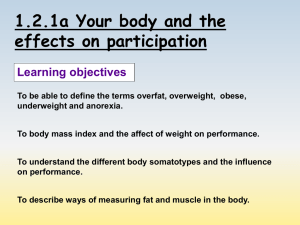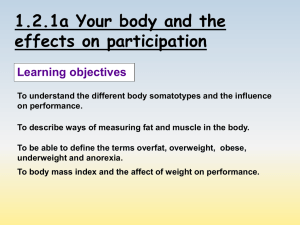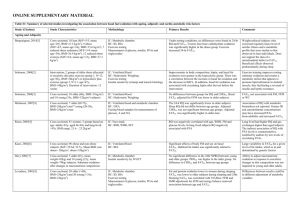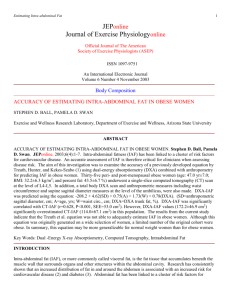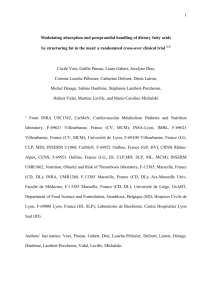Body Composition body_composition1
advertisement
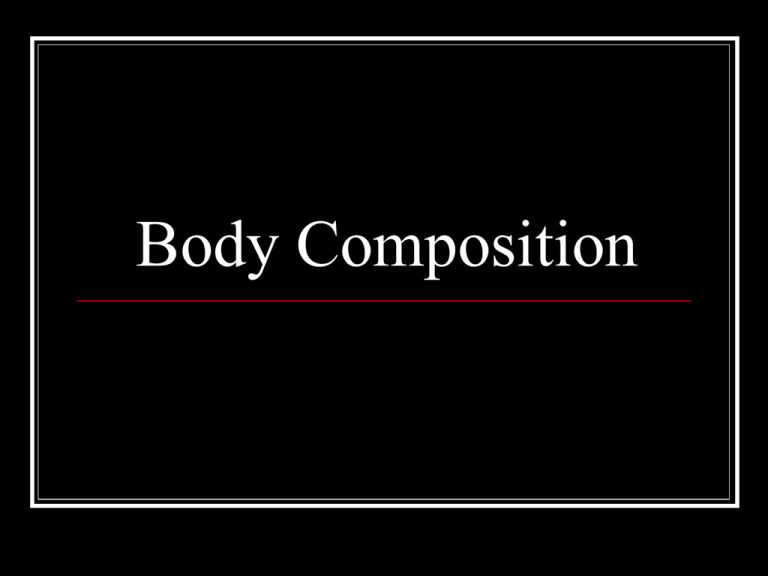
Body Composition Female vs. Males 3-4 inches shorter Weighs 25 – 30 lbs less 10 – 15 lbs more fat tissue Both Men and Women’s increase with age Female vs. Males Both Men and Women’s Body Mass Index increase with age Age Males Females 20 – 29 21.6 25 30 – 39 22.4 24.8 40 - 49 23.4 26.1 50 - 59 24.1 29.3 Over 60 23.1 28.3 Ideal Body Fat 20 – 27% for females Obese over 28% 15 – 19% for males Obese over 23% Types of Fat in the Body Essential fat: In the muscles, heart, lungs, liver, spleen, intestines, kidneys, and bone marrow Storage Fat: adipose tissue Subcutaneous tissue: the layer of adipose tissue directly beneath the skin Adipose Tissue: fatty tissue Fat tissue protecting the internal organs Difference in body fat % W - Higher percentage of essential fat Women need 12% body fat to maintain their essential body-fat stores maintain metabolic homeostasis When below 12%, women experience amenorrhea and hormone irregularities Men only need 3% Increased BF % and Performance Reduction in Performance Especially Endurance Exercise Any activity that requires Body Weight to be supported W - decreased muscle mass W - Increased BF% Increased BF % and Performance Take a look at Table 2.4 (pg 30-31) Females manipulate and maintain BF% to improve performance Optimal BF% for a sport Aesthetic value of having low BF% Body Type Mesomorph Endomorph Ectomorph Measurement of Body Composition Height-Weight Charts least accurate for health risks Body-mass index Waist-to-hip ratio Tanita (BioElectrical Impedence Analysis) Skinfold Measurements Hydrostatic Weighing Bod-Pod Height-Weight Charts (pg 199) Body Frame size Thumb and middle finger around the wrist No overlap – Large frame Touching or barely overlapping – Medium frame Obvious overlap – Small frame Height in 1” heels and elbow breadth Table 8.3 Height-Weight Charts (pg 199) Weight 20% below – Underweight 20% above – Overweight 30% above – Obese Height-Weight Charts (pg 199) Problems Muscularity can throw off chart’s validity Emphasis on body weight rather than body composition Non-Caucasions are underrepresented Age not a factor Weights are too high for young people To low for the elderly Correct for people in 40s Body-Mass Index (BMI) Components Body weight Height Previously Gold Standard Under 25 BMI Interpreting BMI Underweight (under 19) Desirable (19-25) Minimal to low risk Attention to diet Increased physical activity Lifestyle changes Increased health risks (26-29) Moderate risk All of the preceding Low-Calorie diet (800 to 1200 K a day) Interpreting BMI Obese (30-40) High to very high All of the preceding Drug therapy Very low calorie diet Extremely Obese (more than 40) Extremely high risk All of the preceding Surgery intervention Benefits vs. Problems Benefits Quick and easy to understand Problems 5- 10% of the population is incorrectly classified as obese or overweight Lowering of standard from 27 to 25 classified 30 million people as overweight Muscular athletes such as 6 foot, 190lb man and 6’ 1”, 220lb man are overweight and obese with BF% of 10% or less Skinfold Measurements Can be taken in either 9, 7, 4 or 3 locations Triceps Biceps Subscapula Suprailiac Abdominal Medial Calf Midaxillary Front Thigh Chest Triceps Vertical fold Posterior midline of the upper arm Halfway between the acromion (shoulder) and olecranon processes (elbow) Arm held freely to the side of the body Chest Diagonal fold Men: one-half the distance between crease of the underarm and the nipple Women: one-third of the distance between the anterior axillary line and the nipple Midaxillary Vertical or Horizontal fold Midaxillary line at the level of the xiphoid process of the sternum Subscapular Diagonal fold 1 to 2 cm below the inferior angle of the scapula Suprailiac Diagonal fold Anterior axillary line (modern technique) immediately superior to the iliac crest in line with the natural angle of the iliac crest taken Mid-axillary line (traditional technique) Superior to the iliac crest Abdominal Vertical fold 2 cm or 1" to the right side of the umbilicus Vertical fold Anterior midline of the thigh Midway between the proximal border of the patella (upper knee) and the inguinal crease (hip) Other Sites Biceps Vertical fold Anterior aspect of the arm over the belly of the biceps muscle 1 cm above the level used to mark the triceps site Calf Vertical fold maximum circumference of calf on the midline of medial border Tanita (BIA) A quick, fairly accurate percent of body fat uses electrodes attached to the wrists and/or ankles to determine the percentage electronically Hydrostatic Weighing A method of measuring body fat by submerging an individual in water Current Gold Standard for BF% Testing Procedure Sit on a scale in a tank of water Exhales as completely as possible Then submerged for approximately 10 seconds while his or her weight is recorded. Hydrostatic Weighing Proportions of lean body mass and fat mass are determined from calculations that involve Weight underwater Weight out of water Known densities of lean and fatty tissues Hydrostatic Weighing Waist-to-Hip Ratio Provides an indication where you store fat Obese people Abdominal area rather than hips and thighs Hips and thighs Lower risk for the above diseases Men WTH ratio of > 1 Higher risk for coronary heart disease, high bp, congestive heart failure, strokes and diabetes Recommends weight lost Women WTH ratio of > .85 Recommends weight lost Bod Pod Bid Pod
